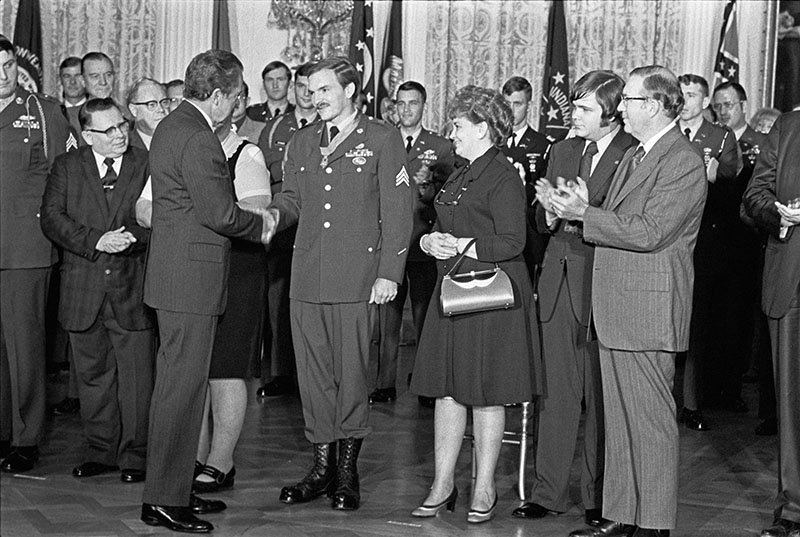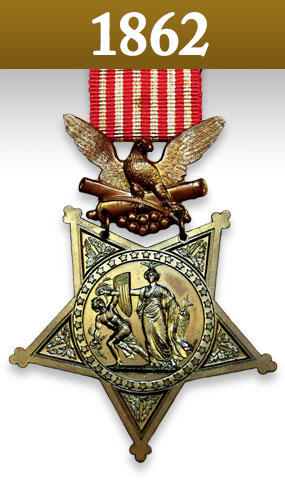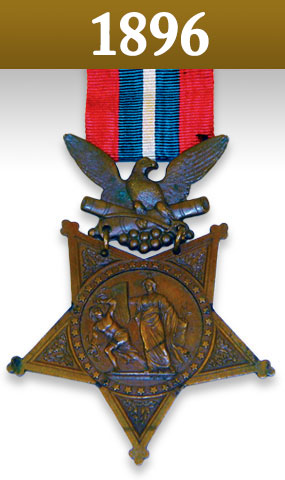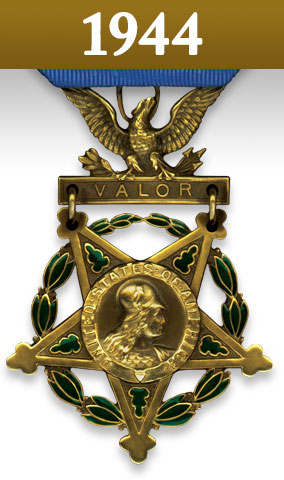The Medal of Honor is our nation’s highest military award for valor. The fierce fighting and deeds of valor that occurred during the American Civil War brought home the realization that such acts should be officially recognized. Taking the example of General George Washington’s earlier experiences of honoring such deeds with the Badge of Military Merit, Congress first authorized the Medal of Honor as a Navy award in 1861 to recognize the valorous acts performed by that Department’s non-commissioned officers and enlisted men. In 1862, Congress authorized a similar award for members of the U.S. Army, and in 1863 extended eligibility to include commissioned officers. In 1963, the law was amended by Congress to allow for the U.S. Air Force to award its own version of the medal. Before that time, Air Force personnel were awarded the Army version of the Medal of Honor.
The original Army version of the medal began as a bronze five-pointed star with one point facing down. The central medallion bears the likeness of Minerva, who personifies the United States. She stands with a left hand resting on fasces (symbolizing authority) and her right hand holding a shield emblazoned with the United States coat of arms. She repulses Discord, represented by snakes. Minerva is encircled by a band of thirty-four stars representing the number of states in the Union at that time. The pendant is suspended by a trophy of crossed cannon, cannon balls, sword, and an American eagle. The clasp that fastened the medal to a uniform consisted of two cornucopias and the arms of the United States.
Congress revised the Army Medal of Honor in 1896 due to widespread misuse and copying of the design by nonmilitary organizations. In addition to writing into law some protections for the medal, the suspension ribbon was changed and a bowknot (Rosette) authorized that could be worn in place of the medal.
On 23 April 1904, Congress authorized a new medal design that had been redrawn by Major General George L. Gillespie. In his version the bronze five-pointed star is superimposed on a green-enameled laurel wreath, with trefoils seen on the rays of the star. The central medallion features the head of Minerva in relief, encircled by the inscription “United States of America.” The pendant hangs from a bar bearing the word “Valor,” and the whole is surmounted by a spread eagle.
The 1904 design remains in use today except for one change. In 1944, the medal was revised from a suspension-type medal to one designed to be worn around the neck. The pendant and bar attach to an octagonal pad of light blue, bearing thirteen stars in the shape of three chevrons, hung on a light blue ribbon that encircles the wearer’s neck. The Medal of Honor is worn outside the shirt collar and inside the coat, hanging above all other decorations. A standard size ribbon bar is included with the medal set. The service ribbon is the same light blue with five stars arranged in the shape of an ‘M.’

Army Special Operations Forces (ARSOF)
Although selected individuals throughout Army history have executed special missions or tasks, it was not until World War II that the first units were deliberately organized, formed, and trained for special operations. Modern Army Special Operations Forces (ARSOF) trace their lineage to such World War II units as the First Special Service Force, the 475th Infantry Regiment, and the original Ranger Battalions. Additional ARSOF legacy units can also be found in elements of the Philippine Guerrillas, Alamo Scouts, Merrill’s Marauders, and the MARS Task Force. ARSOF personnel also served in joint special operations units like the original Observer Group, Amphibious Scouts and Raiders, and select elements of the Office of Strategic Services (OSS). This memorial book includes the achievements of ARSOF Soldiers from World War II through the present day
To date, thirty ARSOF Soldiers have earned our nation’s highest award for valor. Each is included in this memorial book chronologically in the order of the combat action for which the award was earned. One action occurred during World War II, twenty-five in Vietnam, two during Operation GOTHIC SERPENT in Somalia, and two during Operation ENDURING FREEDOM in Afghanistan. Of these thirty ARSOF Medal of Honor awards, fifteen were presented posthumously to surviving family members. This book is dedicated to the preservation of the memory of their valorous actions.

Medal of Honor Entitlements
- Each Medal of Honor recipient may have his name entered on the Medal of Honor Roll (38 USC 560). Each person whose name is placed on the Medal of Honor Roll is certified to the Department of Veterans Affairs as being entitled to receive the special pension of $1,329.58 per month as of 1 December 2017. This amount is adjusted annually based on the Cost of Living Index.
- Enlisted recipients of the Medal of Honor are entitled to a supplemental uniform allowance.
- Special entitlements to air transportation under the provisions of DOD Regulation 4515.13-R.
- Identification card, commissary, and exchange privileges for Medal of Honor recipients and their eligible dependents.
- Children of recipients are eligible for admission to the U.S. Service Academies without regard to the quota requirements.
- Ten percent increase in retired pay under Title 10, USC 3991, subject to the 75% limit on total retired pay.



